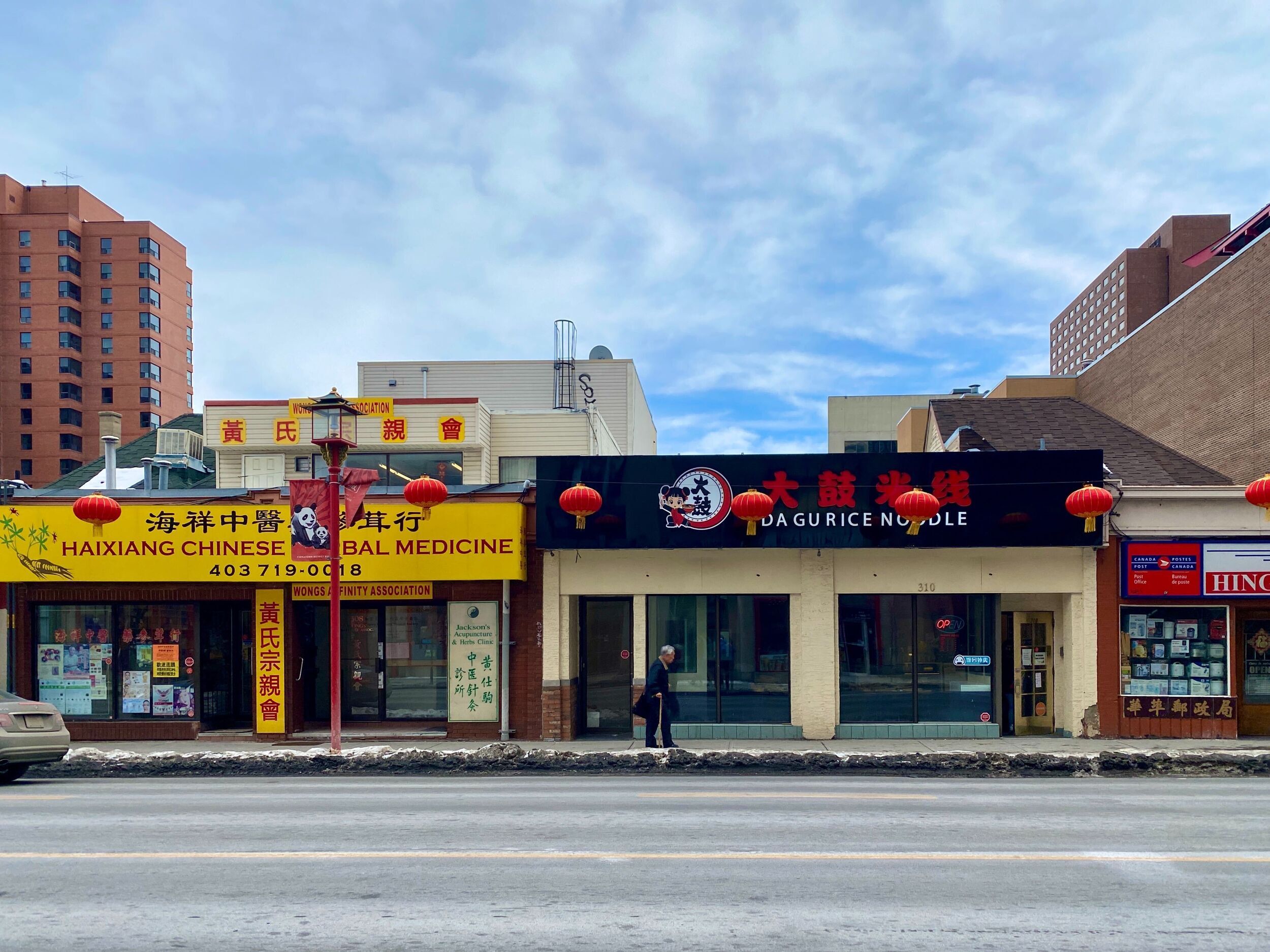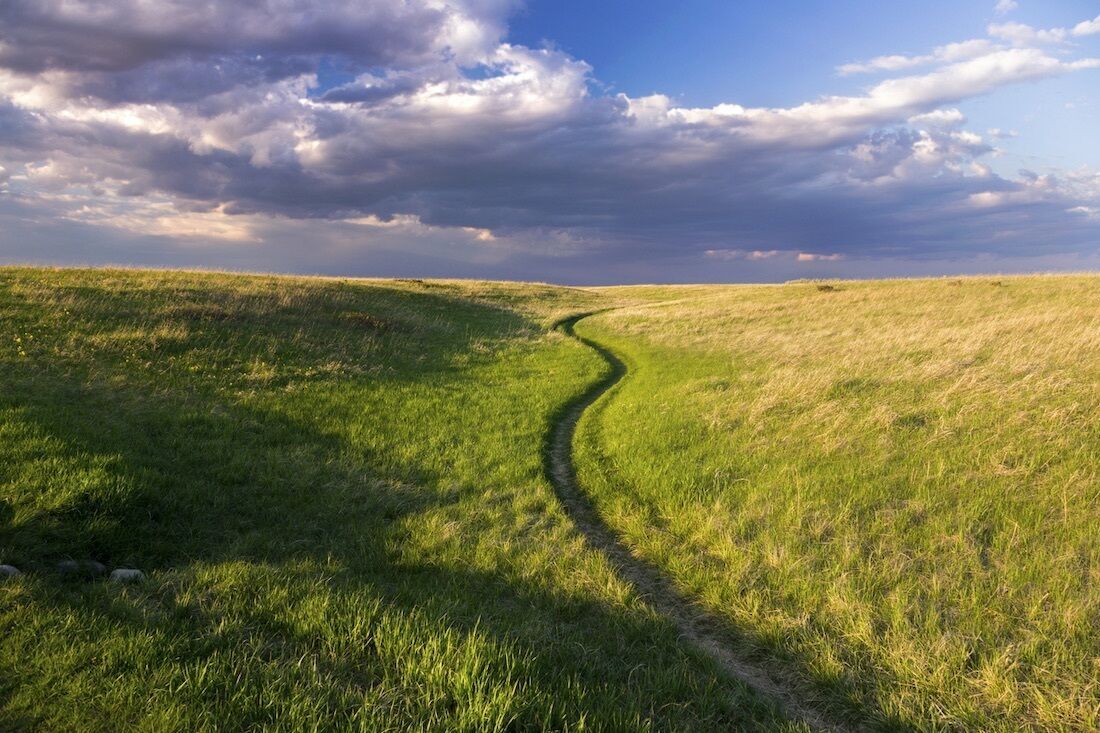
In the 1960s, a freeway was proposed through Chinatown. Photo: Jeremy Klaszus
This city’s ideas of progress can often feel hopeless. From tearing down irreplaceable heritage buildings, to trampling natural environments with sprawling suburbs and freeways, the profit-focused forces that shape Calgary at high levels seem impossible for ordinary people to combat.
For some, Calgary is not so much a community as an investment opportunity.
But there have been important victories by citizens fighting shortsighted developments over the years. Stories that are worth remembering, not only as testament to the power of organizing, but also to understand how we nearly lost city treasures like Nose Hill, Chinatown and Inglewood.
A penetrating proposal
The freeway craze of 1960s urban planning portrayed mega-roads as essential to cities of the future — a future Calgary saw as its own.
With an eye to getting commuters in and out of downtown, the city proposed a freeway running along the south riverbank, cutting between 3rd and 4th Avenues downtown. The proposed freeway had several names, but the best-remembered is the East Calgary Downtown Penetrator.
One minor detail: it would obliterate Chinatown and significant parts of East Village, Inglewood and Ramsay. But why not bulldoze the past to make way for progress?
People living in the area now are ‘generally poor… The aged live lonely lives often in rooms without windows, and sleep in beds without sheets or blankets.’
“Planners Propose Relocating Poor — Freeway By River Urged” announced the October 22, 1965, Calgary Herald.
Adopting the city’s language, the paper reported the “urban renewal” plan as not only necessary but a fine idea, citing planners’ assertions that “people living in the area now are ‘generally poor... the aged live lonely lives often in rooms without windows, and sleep in beds without sheets or blankets.’”
Stan Wong, an active member of the Chinese community in the city at the time, recalls the neighbourhood in less Dickensian terms.
“There were mostly bachelors and older people living there,” he said. “It was kind of run down. There’s no other way of describing it.”
Although Wong didn’t live in Chinatown at the time, he was part of the fight to save one of the oldest areas of the city.
Condemned by both the future freeway and a proposed wider Centre Street Bridge replacement, Chinatown and the Chinese community rallied. The Sien Lok Society was formed directly as a result of the situation, and Wong, its future president, and others, pestered politicians to reconsider, as did Inglewood and Ramsay community groups.
Council effectively iced the plans in 1971 by voting to refurbish the Centre Street Bridge. But the spectre of the Penetrator remained for years: planners proposed another ill-fated four-lane freeway through Inglewood or Ramsay in the mid-'80s.
Nose Hill: Prime real estate with a view
Nose Hill park is something of a miracle, given Calgary’s appetite for greenfield development: a vast piece of natural prairie grassland, tipi rings still visible as a reminder of its importance to the Blackfoot long before colonialism.
The miracle lies in how close we came to paving it over.

In 1969, a new development for 50,000 people on the hill’s steep slopes was proposed by Carma Developers. Considering the difficulty of building sufficient roads in such terrain, the city declared the project was not feasible, and instead offered to allow high-density development on the top of Nose Hill, while developers who owned the land would give the slopes to the city for use as a park.
While the city and developers debated, public opposition to any development on Nose Hill grew. Numerous letters to the editor appeared in the Herald, urging that the hill be spared.
Go up some evening. The grass is yellow now, the wildflowers fragile in withdrawl [sic]; an end-of-summer quiet. But there’s still a meadowlark with its hopeful sound, and the anxious squeaking of the gophers. Birds whip low through the grass, small brown birds that match the earth; they seem to travel in groups of three. In patches you can smell skunk or catch the downwind of horses. [...]
Why are we always such a sensible city? Why are our leaders always sensible men, who never urge us into dreams? It seems we’re going to follow all our sister cities into pavement and withdrawl [sic] from the land. We’re never going to have a big park, one that celebrates what we are. And all we can plan for Nose Hill is an area of expensive houses and access roads, with token parks on the unproductive steep slopes. Maybe we’re a little ashamed of being foothills; pretty bleak country sometimes, pretty plain, might as well cover it all up.
— Sandra Jones, letter to the editor, Calgary Herald, Sept 15, 1971
Community groups and nature organizations mounted strenuous opposition, including letter-writing campaigns and a petition. The issue divided candidates in the 1971 municipal election. A committee representing ten North Calgary communities hit back against Carma’s claim that development was needed to prevent a housing crisis, saying “any crisis over the freezing of Nose Hill would be a crisis only for Carma.”
The issue was stuck in limbo for decades, and even involved a 1984 Supreme Court case between the city and Hartel Holdings, which also owned some of the land. (The dispute, which the city won, centred around the value assigned to the land, and whether the city had the right to buy it up at its own pace.)
Finally, in 1989, the city and the province shared the cost of acquiring the remaining land, and Nose Hill officially became a park.
It was stunning to me that [demolition] could happen to something of such importance.
The Grand: A theatrical drama
Among downtown First Street West’s stellar lineup of beautiful old buildings — the Alberta Hotel, the Grain Exchange, the Hudson’s Bay building, the Palliser Hotel, the Alberta Block, the Central United Church, the Bank of Montreal building — stands the Lougheed Building and the adjacent Grand Theatre.
Now dwarfed by corporate towers, when it was built in 1912 by Senator James Lougheed, the Grand Theatre was a striking and stately feature of the young city. As Donald Smith’s book, Calgary’s Grand Story shows, the history of the city can in some ways be traced through the theatre. As the largest venue in town for many years, the Grand played host to everyone from Bible Bill Aberhart to the Marx Brothers, Fred Astaire, and Sarah Bernhardt.
Naturally, some people wanted to tear it down to build a shiny corporate tower.
In 1998, the owner of the property, Hanover Group, sought to redevelop the site. Hanover was “established in 1996 to exclusively manage the capital of Clive Beddoe and his family,” according to its website. Beddoe, the co-founder of WestJet and much-lauded Calgarian, seemed to be seeking to trade the city’s history for a better ROI.
Bob van Wegen was part of the opposition that mobilized to save the building, designing flyers that were handed out everywhere from downtown to the U of C.

“It was stunning to me that [demolition] could happen to something of such importance,” he said.
A petition for the provincial government to designate the building a protected historic site got over 4,000 signatures—including Peter Lougheed’s, the former premier, who had come to an event in support of saving the building.
“I remember asking him if he would sign the petition, and of course he did,” said van Wegen. With an eye for a headline, he got Lougheed’s permission to tell the media of the endorsement. “We turned that into a news release, and that’s what got us the national coverage.”
Despite the pressure campaign, the Klein government declined to protect the building, saying it was “not in the public interest.”
But with so much opposition and a softening of the economy, the Lougheed-Grand complex remained standing. Its salvation came in the form of Neil Richardson, who purchased the property in 2003 with an eye to preserving it—the narrowest of victories for local heritage.
River Park: No bridge, thank you
Anyone who lived in Calgary around 2009 will likely recall the battle over Plan It Calgary, the city’s attempt to translate the 100-year vision developed in imagineCalgary into an actual plan. Much of that conflict revolved around misconceptions of densification.
But there was another fight, a fight over a proposal to build traffic bridges across Edworthy Park and River Park. The city’s promise that the bridges would be solely for public transit, pedestrians, cyclists, and emergency vehicles did nothing to convince those who thought it daft to put roadways through pristine parks.
Karen Paul was president of the Britannia Community Association at the time, one of the neighbourhoods adjacent to River Park. She recalls that someone went and found the original agreement from Eric Harvie’s donation of the land for River Park in 1956:
It is mutually agreed that the park shall be developed as follows: vehicular traffic will not be allowed and in particular no automobile or bus traffic will be allowed through the park area...
This intriguing development garnered media attention, which helped raise public awareness. Meanwhile, Britannia and other neighbouring communities campaigned hard, the cleverest tactic being a flyer with the Golden Gate bridge superimposed on the Elbow River valley.

“It made it look ridiculous, but it got people’s attention,” said Paul.
There was no shortage of public input when Plan It Calgary went before council, much of it focused on the terrifying spectre of density. When it was Paul’s turn to speak, she saw the campaign had made an impact.
“I recall [mayor Dave] Bronconnier pointing to a huge stack of letters from the public and saying to me, ‘We got the message, Ms. Paul.’” The transit bridges were removed from the final plan; River Park was designated a municipal historical resource in 2014.
Change is inevitable, and nothing lasts forever. But when concerned citizens organize and fight for their values, they can actually beat the odds and win—even in Calgary.
Taylor Lambert is a Calgary writer and the author of Darwin's Moving, which won the 2018 City of Calgary W.O. Mitchell Book Prize.
The Sprawl is crowdfunded, ad-free and made in Calgary. Become a Sprawl member today to support independent local journalism!
Support independent Calgary journalism!
Sign Me Up!The Sprawl connects Calgarians with their city through in-depth, curiosity-driven journalism. But we can't do it alone. If you value our work, support The Sprawl so we can keep digging into municipal issues in Calgary!



